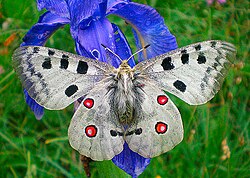Mountain Apollo
| Apollo | |
|---|---|
 |
|
| Parnassius apollo. Upperside | |
 |
|
| Underside | |
| Scientific classification | |
| Kingdom: | Animalia |
| Phylum: | Arthropoda |
| Class: | Insecta |
| Order: | Lepidoptera |
| Family: | Papilionidae |
| Genus: | Parnassius |
| Species: | P. apollo |
| Binomial name | |
|
Parnassius apollo (Linnaeus, 1758) |
|
| External identifiers for Parnassius apollo | |
|---|---|
| Encyclopedia of Life | 128851 |
| NCBI | 110799 |
| Also found in: , Fauna Europaea | |
Not to be confused with Apollo, the Greek god.
The Apollo or mountain Apollo (Parnassius apollo), is a butterfly of the Papilionidae family.
The species is named in the classical tradition for the deity Apollo.
Subspecies include:
For a more complete list of subspecies and type details of specimens in the British Museum (Natural History) see Ackery, P. R. (1973) A list of the type-specimens of Parnassius (Lepidoptera: Papilionidae) in the British Museum (Natural History). Bulletin of the British Museum (Natural History) (Entomology) 29 (1) (9.XI.1973): 1—35, 1 pl. online here
This typically mountain species prefers hills and flowery alpine meadows and pastures of the continental European mountains, in Spain, Scandinavia and Central Europe, in the Balkans up to northern Greece and in the Alps between Italy and France.
It is also present in some areas of the central Asia (Sakha). Typical of high altitudes, its range is from 400 metres (1,300 ft) up to 2,300 metres (7,500 ft), although it is far more present above 1,000 metres (3,300 ft).
This species requires specific climatic conditions (cold winter, sunny summer). It also requires wide open spaces (with a cover of shrubs less than 5%) and a large surface of lawns (at least 50%). The presence of the host plant for the caterpillars is critical.
Parnassius apollo has a wingspan of 62–86 millimetres (2.4–3.4 in) in males, of 65–95 millimetres (2.6–3.7 in) in females. The Apollo butterfly shows a great deal of individual variation in the appearance, with an evident colour polymorphism. These very very large, beautiful and conspicuous white butterflies are decorated with five large black eyespots on the forewing and two bright red or sometimes orange eyespots on the hindwing. These striking red eyespots can vary in size and form depending on the location of the Apollo butterfly, and the bright red colour often fades in the sun, causing the eyespots of older individuals to appear more orange. The wings are shiny, with slightly transparent edges, and some individuals are darker (sphragismelanistic); a general phenomenon common in many butterflies. The caterpillars of this species are velvety black with orange-red spots along the sides.
...
Wikipedia

